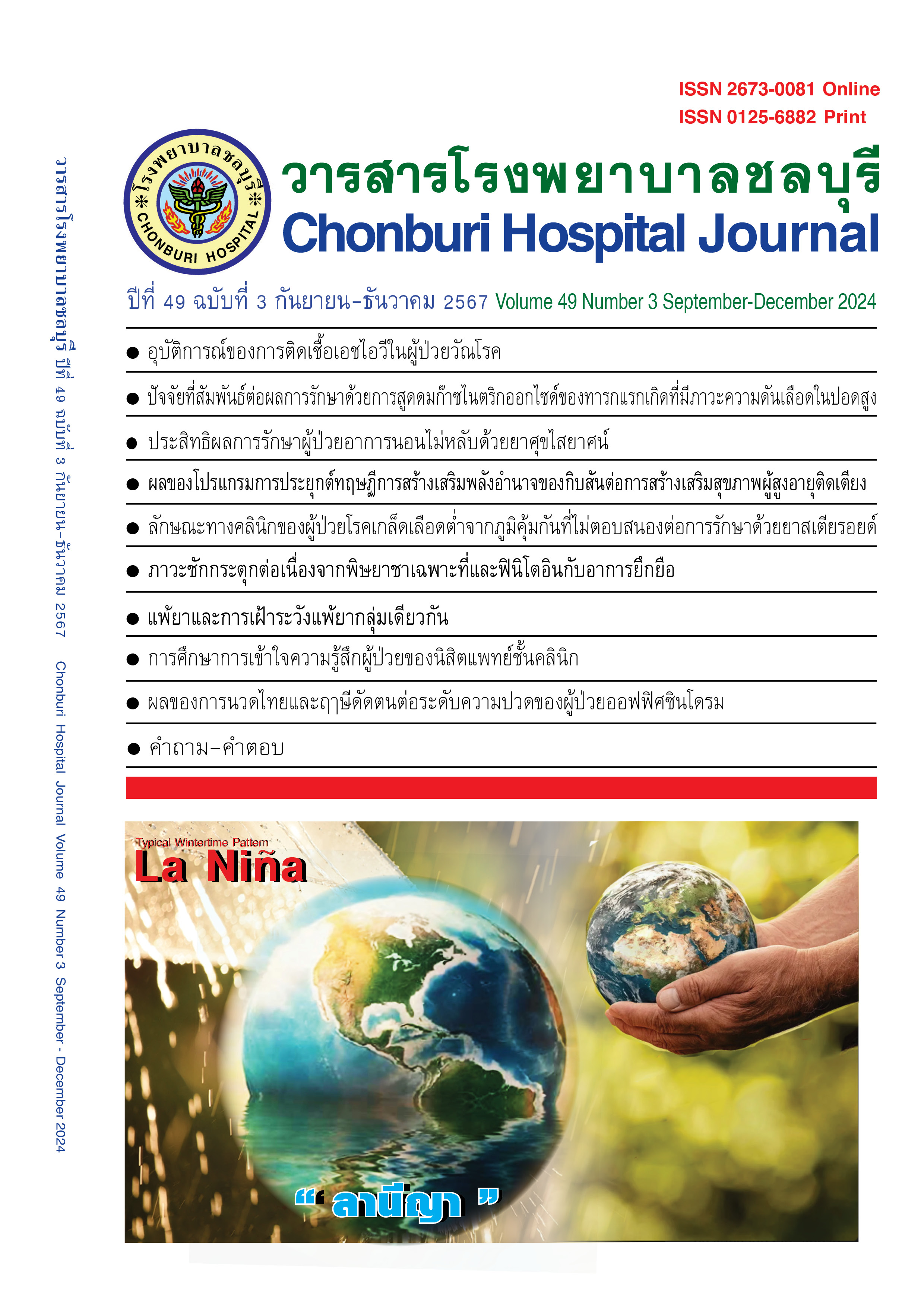The Treatment Outcomes and Related Factors of Inhaled Nitric Oxide in Newborns with Persistent Pulmonary Hypertension at Chonburi Hospital
Abstract
Background: Persistent pulmonary hypertension of the newborn (PPHN) leads to neonatal respiratory failure and death. Currently, inhaled nitric oxide (iNO) is one of the treatments for PPHN. Research on the outcomes of iNO treatment and the factors that affect those outcomes is important for developing more effective care processes for newborns with PPHN.
Objective: To investigate nitric oxide inhalation therapy results and factors predicting treatment outcomes in newborns with PPHN.
Methods: This historical cohort study collected data from newborns with PPHN who received iNO treatment in Chonburi Hospital from September 2019 to September 2023. Chi square test, independent t-test, and logistic regression analysis were used to analyze the factors associated with the outcome of iNO therapy with statistical significance p<0.05.
Results: Ninety-two newborns with PPHN received iNO therapy. The neonatal mortality rate after iNO treatment was 33.7%. The factors affecting the mortality rate included higher heart rate (AOR 1.04, 95%CI 1.01, 1.07) and higher oxygen index (AOR 1.03, 95%CI 1.01, 1.06) when starting iNO therapy, and pulmonary hemorrhage (AOR 4.63, 95%CI 1.37, 15.67).
Conclusions: Newborns with PPHN who were treated with iNO therapy have a survival rate of 66.3%. Factors that associated with treatment outcomes include heart rate and oxygen index before starting therapy, and the existence of pulmonary hemorrhage.
Keywords : Persistent pulmonary hypertension of the newborn, Inhaled nitric oxide therapy, Mortality rate, Related factors of treatment outcome
References
) Robin HS. Pulmonary vascular development. In: Richard JM, Away AF, Michele CW, editors. Fanaroff & Martin's neonatal-perinatal medicine. 11th ed. Philadelphia: Mosby Elsevier; 2020. p. 1306-19.
) Nakwan N. The practical challenges of diagnosis and treatment options in persistent pulmonary hypertension of the newborn: a developing country's perspective. Am J Perinatol 2018;35(14):1366-75.
) Nakwan N, Jain S, Kumar K, Hosono S, Hammoud M, Elsayed YY, et al. An Asian multicenter retrospective study on persistent pulmonary hypertension of the newborn: incidence, etiology, diagnosis, treatment and outcome. J Matern Fetal Neonatal Med 2020;33(12):2032-7.
) Panaarunwong C. Persistent pulmonary hypertension of the newborn at Nakhon Phanom Hospital. Nakhon Phanom Hosp J 2018;4(2):5-18.
) Nakwan N, Pithaklimnuwong S. Acute kidney injury and pneumothorax are risk factors for mortality in persistent pulmonary hypertension of the newborn in Thai neonates. J Matern Fetal Neonatal Med 2016;29(11):1741-6.
) Pongsopa N. Persistent pulmonary hypertension of the newborn at Suratthani Hospital. Reg11 Med J 2018;31(1):49-55.
) Jirapiti U. Clinical characteristics of newborn infants with pulmonary hypertension in Chiang Rai Prachanukroh Hospital. Chiang Rai Med J 2014;6:57-65.
) Ekwitchakul D, Thamwiriyakul N. Mortality rate of newborns with persistent pulmonary hypertension [dissertation]. Pediatric Department, Chonburi : Chonburi Hospital; 2019.
) Mat Bah MN, Tan RYH, Razak H, Sapian MH, Abdullah N, Alias EY. Survival and associated risk factors for mortality among infants with persistent pulmonary hypertension of the newborn in Malaysia. J Perinatol 2021;41:786–93.
) Nair J, Lakshminrusimha S. Update on PPHN: mechanisms and treatment. Semin Perinatol 2014;38(2):78-91.
) Jaroensri S, Kamolvisit W, Nakwan N. Risk factor analysis of pneumothorax associated with persistent pulmonary hypertension of the newborn in Thai neonate. J Matern Fetal Neonatal Med 2020;33(24):4090-5.
) Mathew B, Lakshminrusimha S. Persistent pulmonary hypertension in the newborn. Children (Basel) 2017;4(8):63.
) Siefkes HM, Lakshminrusimha S. Management of systemic hypotension in term infants with persistent pulmonary hypertension of the newborn: an illustrated review. Arch Dis Child Fetal Neonatal Ed 2021;106(4):446-55.
) Lakshminrusimha S, Keszler M. Persistent pulmonary hypertension of the newborn. NeoReviews 2015;16(12):e680-92.
) Muniraman HK, Song AY, Ramanathan R, Fletcher KL, Kibe R, Ding L, et al. Evaluation of oxygen saturation index compared with oxygenation index in neonates with hypoxemic respiratory failure. JAMA Netw Open 2019;2(3):e191179.
) Lazar DA, Cass DL, Olutoye OO, Welty SE, Fernandes CJ, Rycus PT, et al. The use of ECMO for persistent pulmonary hypertension of the newborn: a decade of experience. J Surg Res 2012;177(2):263-7.
) Gezmu AM, Tefera E, Mochankana K, Imran F, Joel D, Pelaelo I, et al. Pulmonary hemorrhage and associated risk factors among newborns admitted to a tertiary level neonatal unit in Botswana. Front Pediatr 2023;11:1171223.
) Wang TT, Zhou M, Hu XF, Liu JQ. Perinatal risk factors for pulmonary hemorrhage in extremely low-birth-weight infants. World J Pediatr 2020;16(3):299-304.
Downloads
Published
Versions
- 2025-01-08 (2)
- 2025-01-02 (1)
Issue
Section
License

This work is licensed under a Creative Commons Attribution-NonCommercial-NoDerivatives 4.0 International License.
บทความที่ได้รับการตีพิมพิ์เป็นลิขสิทธิ์ของวารสารโรงพยาบาลชลบุรี
